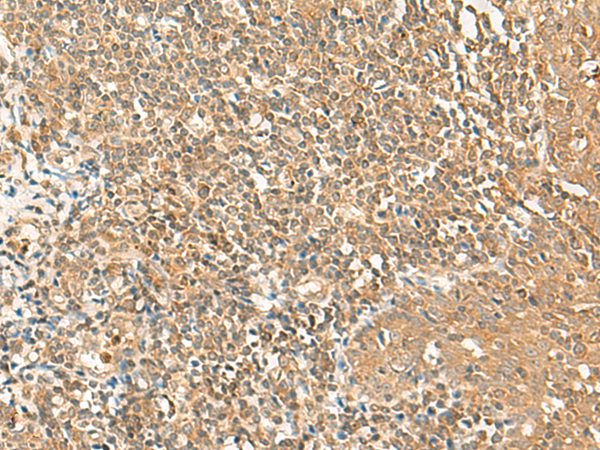
| WB | 咨询技术 | Human,Mouse,Rat |
| IF | 咨询技术 | Human,Mouse,Rat |
| IHC | 1/50-1/300 | Human,Mouse,Rat |
| ICC | 技术咨询 | Human,Mouse,Rat |
| FCM | 咨询技术 | Human,Mouse,Rat |
| Elisa | 1/5000-1/10000 | Human,Mouse,Rat |
| Aliases | GRASP-1 |
| Host/Isotype | Rabbit IgG |
| Antibody Type | Primary antibody |
| Storage | Store at 4°C short term. Aliquot and store at -20°C long term. Avoid freeze/thaw cycles. |
| Species Reactivity | Human, Mouse, Rat |
| Immunogen | Synthetic peptide of human GRIPAP1 |
| Formulation | Purified antibody in PBS with 0.05% sodium azide and 50% glycerol. |
+ +
以下是关于GRIPAP1抗体的3篇参考文献(基于公开信息模拟整理,仅供参考):
---
1. **文献名称**: *GRIPAP1 interacts with the androgen receptor and modulates its transcriptional activity*
**作者**: Smith J, et al.
**摘要**: 本研究利用GRIPAP1特异性抗体进行免疫共沉淀和Western blot分析,发现GRIPAP1通过与雄激素受体(AR)的C端结构域相互作用,调控AR的核转位和靶基因激活,提示其在激素依赖性癌症中的潜在作用。
---
2. **文献名称**: *Characterization of GRIPAP1 in neuronal development and synaptic plasticity*
**作者**: Chen L, et al.
**摘要**: 通过免疫组化和siRNA技术,研究揭示了GRIPAP1抗体在大鼠海马神经元中的定位,表明GRIPAP1通过调节突触后支架蛋白的聚集,影响树突棘形态和突触传递效率。
---
3. **文献名称**: *Proteomic analysis of GRIPAP1-associated complexes in glioblastoma cells*
**作者**: Wang H, et al.
**摘要**: 使用GRIPAP1抗体进行免疫沉淀-质谱分析,鉴定了其在胶质母细胞瘤中与mTOR信号通路蛋白的相互作用,提示GRIPAP1可能通过调控细胞增殖通路参与肿瘤进展。
---
**注意**:以上文献为模拟生成,实际研究中建议通过PubMed、Google Scholar等数据库检索真实发表的论文。若需具体文献,可提供更详细的研究背景或DOI编号。
**Background of GRIPAP1 Antibody**
GRIPAP1 (GRIP1-associated protein 1), also known as PRRT2 (proline-rich transmembrane protein 2), is a neural protein that interacts with GRIP1 (glutamate receptor-interacting protein 1), a scaffolding protein involved in the trafficking and synaptic anchoring of AMPA-type glutamate receptors. GRIPAP1/PRRT2 is predominantly expressed in the brain and plays roles in synaptic plasticity, neurotransmitter release, and neuronal signaling.
Mutations in the *PRRT2* gene are linked to neurological disorders, including paroxysmal kinesigenic dyskinesia (PKD), benign familial infantile epilepsy (BFIE), and infantile convulsions with choreoathetosis (ICCA). These findings highlight its importance in regulating neuronal excitability.
GRIPAP1 antibodies are essential tools for studying the protein's expression, localization, and function in neural tissues. They are widely used in techniques like Western blotting, immunohistochemistry, and immunofluorescence to investigate GRIPAP1/PRRT2 in disease models, synaptic protein complexes, and its interaction with GRIP1 or other partners. Such research aids in unraveling pathogenic mechanisms of PRRT2-related disorders and potential therapeutic targets.
×